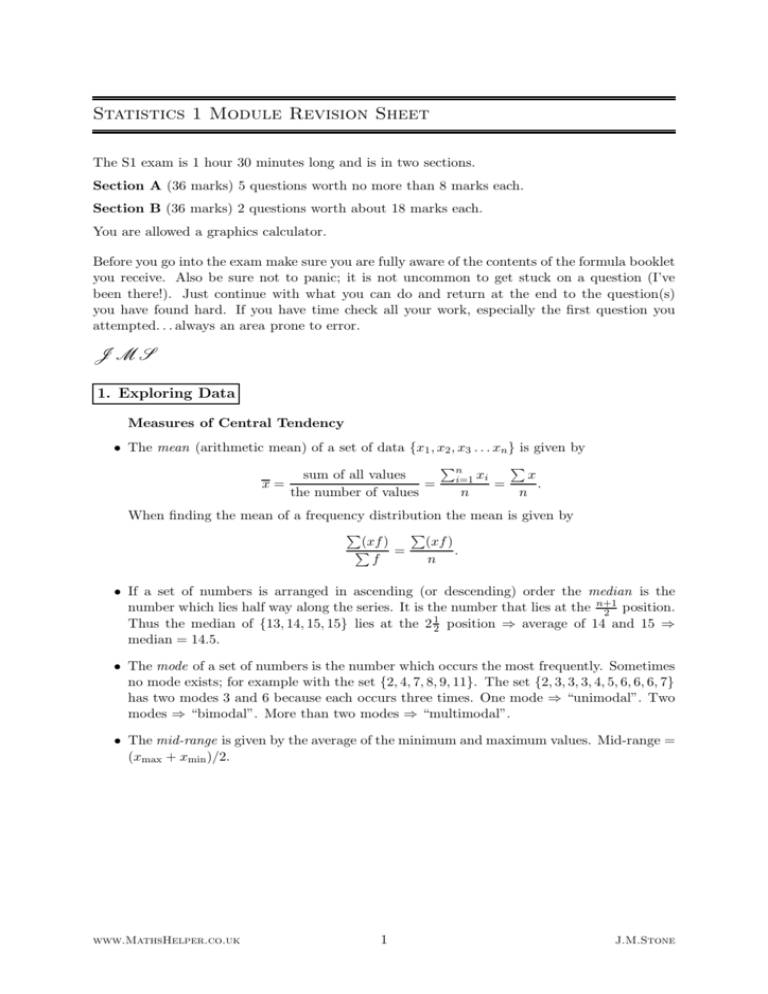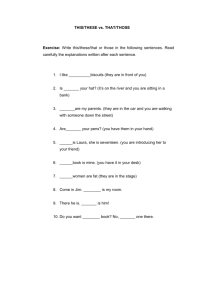MEI S1 (Statistics 1) Revision Sheet
advertisement

Statistics 1 Module Revision Sheet
The S1 exam is 1 hour 30 minutes long and is in two sections.
Section A (36 marks) 5 questions worth no more than 8 marks each.
Section B (36 marks) 2 questions worth about 18 marks each.
You are allowed a graphics calculator.
Before you go into the exam make sure you are fully aware of the contents of the formula booklet
you receive. Also be sure not to panic; it is not uncommon to get stuck on a question (I’ve
been there!). Just continue with what you can do and return at the end to the question(s)
you have found hard. If you have time check all your work, especially the first question you
attempted. . . always an area prone to error.
JMS
1. Exploring Data
Measures of Central Tendency
• The mean (arithmetic mean) of a set of data {x1 , x2 , x3 . . . xn } is given by
Pn
P
sum of all values
x
i=1 xi
x=
=
=
.
the number of values
n
n
When finding the mean of a frequency distribution the mean is given by
P
P
(xf )
(xf )
P
.
=
n
f
• If a set of numbers is arranged in ascending (or descending) order the median is the
number which lies half way along the series. It is the number that lies at the n+1
2 position.
Thus the median of {13, 14, 15, 15} lies at the 2 21 position ⇒ average of 14 and 15 ⇒
median = 14.5.
• The mode of a set of numbers is the number which occurs the most frequently. Sometimes
no mode exists; for example with the set {2, 4, 7, 8, 9, 11}. The set {2, 3, 3, 3, 4, 5, 6, 6, 6, 7}
has two modes 3 and 6 because each occurs three times. One mode ⇒ “unimodal”. Two
modes ⇒ “bimodal”. More than two modes ⇒ “multimodal”.
• The mid-range is given by the average of the minimum and maximum values. Mid-range =
(xmax + xmin )/2.
www.MathsHelper.co.uk
1
J.M.Stone
Mean
Median
Mode
Advantages
⋆ The best known average.
⋆ Can be calculated exactly.
⋆ Makes use of all the data.
Disadvantages
⋆ Greatly affected by extreme values.
⋆ Can’t be obtained graphically.
⋆ When the data are discrete can give an
impossible figure (2.34 children).
⋆ Can be used in further statistical work.
⋆ Can represent an actual value in the
data.
⋆ Can be obtained even if some of the
values in a distribution are unknown.
⋆ Unaffected by irregular class widths
and unaffected by open-ended classes.
⋆ Not influenced by extreme values.
⋆ Unaffected by extreme values.
⋆ Easy to calculate.
⋆ Easy to obtain from a histogram.
⋆ For grouped distributions its value can
only be estimated from an ogive.
⋆ When only a few items available or
when distribution is irregular the median
may not be characteristic of the group.
⋆ Can’t be used in further statistical calculations.
⋆ May exist more than one mode.
⋆ Can’t be used for further statistical
work.
⋆ When the data are grouped its value
cannot be determined exactly.
Measures of Spread
• The simplest measure of spread is the range. Range = xmax − xmin .
P
• The mean absolute deviation from the mean is given by n1
|x − x|. For example in the
data set {4, 5, 7, 8} the mean is 6, so the absolute deviations are 2, 1, 1, 2 so the mean
absolute deviation is 41 (2 + 1 + 1 + 2) = 1.5.
• The sum of squares from the mean is called the sum of squares and is denoted
X
X
Sxx =
(x − x)2 =
x2 − nx2 .
P 2
For example
given
the
data
set
{3,
6,
7,
8}
the
mean
is
6;
x = 9 + 36 + 49 + 64 = 158;
P 2
2
2
1
so Sxx =
x − nx = 158 − 4 × 6 = 14.
P 2
Sxx
x − nx2
• The mean square deviation is defined: msd =
=
.
n
n
rP
r
√
Sxx
x2 − nx2
• The root mean square deviation is defined: rmsd = msd =
=
.
n
n
P 2
Sxx
x − nx2
• The variance is defined: variance =
=
.
n−1
n−1
sP
r
√
x2 − nx2
Sxx
=
.
• The standard deviation (s) is defined: s = variance =
n−1
n−1
• On graphical calculators from Casio the rmsd is given by ‘xσn ’ and the sd by ‘xσn−1 ’.
• Example: Given the set of data {5, 7, 8, 9, 10, 10, 14} calculate the standard deviation.
Firstly we note that x = 9.
sP
r
r
x2 − nx2
Sxx
(52 + · · · + 142 ) − 7 × 92
=
=
s=
n−1
n−1
6
r
615 − 567 √
= 8 = 2.8284 . . .
=
6
1
Or we could have done Sxx =
www.MathsHelper.co.uk
P
(x − x)2 = (3 − 6)2 + (6 − 6)2 + (7 − 6)2 + (8 − 6)2 = 14.
2
J.M.Stone
• When dealing with frequency distributions such as
x
f
1
4
2
5
3
7
4
5
5
, we could cal4
culate the rmsd or the sd by writing out the data2 and carrying out the calculations as
above, but this is clearly slow and inefficient.3 To our rescue come formulae for rmsd and
sd that allow direct calculation from the table. They are
sP
rP
(x2 f ) − nx2
(x2 f ) − nx2
sd =
.
rmsd =
n
n−1
• Example: Calculate mean and sd for the above frequency distribution. For easy calculation
we need to add certain columns to the usual x and f columns thus;
x
1
2
3
4
5
So x =
P
f
4
5
7
5
4
P
n = f = 25
(xf )
75
=
= 3 and s =
n
25
sP
xf
4
10
21
20
20
P
(xf ) = 75
(x2 f ) − nx2
=
n−1
x2 f
4
20
63
80
100
P 2
(x f ) = 267.
r
267 − 25 × 32
= 1.3228 . . .
24
• An item of data is an outlier if it is more than two standard deviations from the mean
(i.e. outlier if |x − x| > 2s). It means that some more investigation is needed to see if it
needs to be discarded. 95% of the data lie within two standard deviations and 99.75% lie
within three standard deviations (assuming normally distributed population).
• Linear Coding. Given the set of data {2, 3, 4, 5, 6} we can see that x = 4 and it can be
calculated that s = 1.581 (3dp). If we add 20 to all the data points we can see that
the mean becomes 24 and the standard deviation will be unchanged. If the data set is
multiplied by 3 we can see that the mean becomes 12 and the standard deviation would
become three times as large (4.743 (3dp)).
Combining the above ideas we find that given a data set xi and we transform it to create
a new data set yi = axi + b then the new mean will be y = ax + b and the new standard
deviation will be sy = asx . This can be used to make certain calculations easier. For
example;
x
164
168
172
176
f
2
3
4
4
⇒
⇒
⇒
⇒
Convert y = x−160
4 ,
therefore x = 4y + 160
⇒
⇒
⇒
⇒
y
1
2
3
4
f
2
3
4
4
Once we find y and sy we find that x = 4y + 160 and sx = 4sy .
2
3
{1, 1, 1, 1, 2, 2, 2, 2, 2, 3, 3, 3, 3, 3, 3, 3, 4, 4, 4, 4, 4, 5, 5, 5, 5}!!!
Indeed, it would be nearly impossible if the frequencies were in the thousands.
www.MathsHelper.co.uk
3
J.M.Stone
3. Probability
• An independent event is one which has no effect on subsequent events. The events of
spinning a coin and then cutting a pack of cards are independent because the way in
which the coin lands has no effect on the cut. For two independent events A & B
P (A and B) = P (A) × P (B).
For example a fair coin is tossed and a card is then drawn from a pack of 52 playing cards.
Find the probability that a head and an ace will result.
P (head) = 21 ,
P (ace) =
4
52
=
1
13 ,
so P (head and ace) =
1
2
×
1
13
=
1
26 .
• Mutually Exclusive Events. Two events which cannot occur at the same time are called
mutually exclusive. The events of throwing a 3 or a 4 in a single roll of a fair die are
mutually exclusive. For any two mutually exclusive events
P (A or B) = P (A) + P (B).
For example a fair die with faces of 1 to 6 is rolled once. What is the probability of
obtaining either a 5 or a 6?
P (5) = 16 ,
P (6) = 16 ,
so P (5 or 6) =
1
6
+
1
6
= 13 .
• Non-Mutually Exclusive Events. When two events can both happen they are called nonmutually exclusive events. For example studying English and studying Maths at A Level
are non-mutually exclusive. By considering a Venn diagram of two events A & B we find
P (A or B) = P (A) + P (B) − P (A and B),
P (A ∪ B) = P (A) + P (B) − P (A ∩ B).
• Tree Diagrams. These may be used to help solve probability problems when more than
one event is being considered. The probabilities on any branch section must sum to one.
You multiply along the branches to discover the probability of that branch occurring.
For example a box contains 4 black and 6 red pens. A pen is drawn from the box and it
is not replaced. A second pen is then drawn. Find the probability of
(i) two red pens being obtained.
(ii) two black pens being obtained.
(iii) one pen of each colour being obtained.
(iv) two red pens given that they are the same colour.
Draw tree diagram to discover:
R = 5/9
R = 6/10
B = 4/9
R = 6/9
B = 4/10
6
10
5
9
=
×
3
9
=
12
90
=
2
15 .
(iii) P (one of each colour) = 1 −
30
90
−
12
90
=
(iv) P (two reds | same colour) =
1/3
1/3+2/15
(i) P (two red pens) =
(ii) P (two black pens) =
×
4
10
30
90
= 13 .
8
15 .
= 57 .
B = 3/9
www.MathsHelper.co.uk
4
J.M.Stone
• Conditional Probability. In the above example we see that the probability of two red pens
is 13 , but the probability of two red pens given that both pens are the same colour is 57 .
This is known as conditional probability. P (A | B) mean the probability of A given that
B has happened. It is governed by
P (A | B) =
P (A ∩ B)
P (A and B)
=
.
P (B)
P (B)
For example if there are 120 students in a year and 60 study Maths, 40 study English and
10 study both then
P (study English | study Maths) =
P (study Maths & English)
10/120
1
=
= .
P (study Maths)
60/120
6
• A is independent of B if P (A) = P (A | B) = P (A | B ′ ). (i.e. whatever happens in B the
probability of A remains unchanged.) For example flicking a coin and then cutting a deck
of cards to try and find an ace are independent because
P (cutting ace) = P (cutting ace | flick head) = P (cutting ace | flick tail) =
1
13 .
4. Discrete Random Variables
• The table below shows the probability distribution for the outcome (X) of a die.
r
P (X = r)
1
2
3
4
5
6
1
6
1
6
1
6
1
6
1
6
1
6
• In general for any event, the probability distribution is of the form
r
P (X = r)
r1
p1
r2
p2
r3
p3
r4
p4
r5
p5
r6
p6
···
···
• The expected value of the event is denoted E(X) or µ. It is defined
E(X) = µ =
For example for a fair die
E(X) = 1 ×
= 3 12 .
1
6
+ 2×
1
6
X
+ 3×
1
6
rP (X = r) .
+ 4×
1
6
+ 5×
1
6
+ 6×
1
6
• The variance of an event is denoted Var(X) or σ 2 and is defined
Var(X) = σ 2 = E(X 2 ) − [E(X)]2 = E(X 2 ) − µ2 =
So for the biased die with distribution
r
P (X = r)
www.MathsHelper.co.uk
1
2
1
3
1
6
5
3
0
4
0
X
5
6
1
6
1
3
r 2 P (X = r) − µ2 .
J.M.Stone
we find that
E(X) = 1 ×
1
3
and
+ 2×
1
6
+ (3 × 0) + (4 × 0) + 5 ×
1
6
+ 6×
1
3
= 3 21
X
r 2 P (X = r) − µ2
2
= 12 × 13 + 22 × 61 + 32 × 0 + 42 × 0 + 52 × 16 + 62 × 13 − 3 21
Var(X) =
2
11
= 17 16 − 3 12 = 4 12
.
• The other way of calculating these quantities is by using a table. We will consider the
example of the bias die above.
r
1
2
3
4
5
6
P (X = r)
1
3
1
6
0
0
1
6
1
3
r 2 P (X = r)
12 × 13 = 13
22 × 16 = 23
32 × 0 = 0
42 × 0 = 0
52 × 61 = 4 16
62 × 31 = 12
P 2
r P (X = r) = 17 16
rP (X = r)
1 × 31 = 13
2 × 61 = 13
3×0=0
4×0=0
5 × 61 = 56
6 × 31 = 2
P
rP (X = r) = 3 12
2
So, as before E(X) = 3 12 and Var(X) = 17 61 − 3 12 = 4 11
12 .
5. Further Probability
• Factorials are defined n! = n × (n − 1) × (n − 2) × · · · × 2 × 1. Many expressions involving
factorials simplify with a bit of thought. For example n!/(n − 2)! = n(n − 1). Also there
is a convention that 0! = 1.
• The number of ways of arranging n different objects in a line is n! For example how many
different arrangements are there if 4 different books are to be placed on a bookshelf?
There are 4 ways in which to select the first book, 3 ways in which to choose the second
book, 2 ways to pick the third book and 1 way left for the final book. The total number
of different ways is 4 × 3 × 2 × 1 = 4!
• Several events. If there are 3 roads from A to B and 2 roads from B to C. How many
routes are there from A to C?
x
u
y
A
B
v
C
z
The solution to our problem is 3 × 2 = 6 because the set of possible routes is
x→u
y→u
z→u
x→v
y→v
z → v.
In general if there are a ways for trial A to result, b ways for trial B to result and c ways
for trial C to result then there are a × b × c different possible outcomes.
www.MathsHelper.co.uk
6
J.M.Stone
• Permutations. The number of ways of selecting r objects from n when the order of the
selection matters is n Pr . It can be calculated by
n
Pr =
n!
.
(n − r)!
For example in how many ways can the gold, silver and bronze medals be awarded in a
race of ten people? The order in which the medals are awarded matters, so the number
of ways is given by 10 P3 = 720.
In another example how many words of four letters can be made from the word CONSIDER? This is an arrangement of four out of eight different objects where the order
matters so there are 8 P4 = 8!/4! = 1680 different words.
• Combinations. The number of ways of selecting r objects from n when the order of the
selection does not matter is n Cr . It can be calculated by
n
Cr =
n!
.
r! (n − r)!
For example in how many ways can a committee of 5 people be chosen from 8 applicants?
Solution is given by 8 C5 = 8!/(5! × 3!) = 56.
In another example how many ways are there of selecting your lottery numbers (where
one selects 6 numbers from 49)? It does not matter which order you choose your numbers,
so there are 49 C6 = 13 983 816 possible selections.
www.MathsHelper.co.uk
7
J.M.Stone









